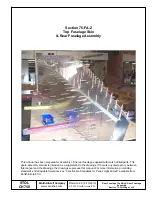
l
F.8L Falco Construction Manual
16–5
Revision 4, March 1, 2002
humidity. The rib drawings show a number of new details. There are now rib drawings for the
Sta. 0 ribs for the stabilizer rib, for example.
The original drawings did not show the fairings for the tail group. These new drawings now show
the fairings. Since the rudder fairings are installed with screws, the ribs to which they are screwed
have been increased to a thickness of 10mm. To allow for the installation and removal of the
outboard elevator hinge bolts and the upper rudder hinge bolt, the extra rib has been moved
slightly to provide clearance.
Drain and vent holes are now shown in all appropriate locations. The vent holes are 1/8ӯ and
are provided so that no closed compartment is created to trap the air. Drain holes are located in
the bottom of the elevator, stabilizer and rudder. These drain holes are shown as 1/8ӯ, but if you
wish, the drain holes may be 1/4ӯ as well.
The trim tab hinge is now shown as being installed with No. 6x1/2” TRA screws. Originally, this
hinge was installed with flat head screws, but some builders complained that the hinge was
difficult to countersink. Once countersunk, the material is so thin that only part of the head of
the screw was engaging the hinge material, so some builders have gone to the trouble of dimpling
and countersinking the screws in the hinges. By carefully locating the screws so that the screw
heads are offset from the screws “across the way”, ordinary truss head screws can be used for a
simpler installation.
An aluminum tube is installed in the stabilizer for the trim tab control cable. This tube allows the
cable to be removed. To hold the tube in place, the old drawings showed a hose clamp fastened
by screw and nut to a spruce block on the Sta. 1 stabilizer rib. To simplify the construction, the
drawings now show the tube epoxied to a block of spruce in the main stabilizer spar, but the screw
and clamp method may still be used.
There are a lot of new details shown so that little will be left to your imagination. Whenever
possible, the details incorporate details previously shown elsewhere. The elevator balance weight
installation is now shown as part of a detail for the elevator hinge installation.
Many builders have experienced great difficulty in understanding how the tail section of the
fuselage is skinned. In a word, the fuselage tail section is skinned all the way back to the main fin
spar. This forms a continuous plywood tube which is very strong torsionally. In order to skin this,
a number of gluing strips are required, and these are shown on the drawings. Because of the
difficulty of sanding the angle on these strips, the gluing strips are drawn so that the angles can be
sanded in advance.
Some of the more frustrating design details of the tail group are the installation of the tail light
and the routing of the wiring to the light. The new drawings show the tail light installation and
wires as well. The principal difficulty comes from the small amount of space available. In most
aircraft, an electrical connector is used so that the rudder may be removed. As you can see from
Drawing No. 402, Section B-B, there is not enough room for such a connector. Even if a
connector were installed, an additional connector would be required on the aft face of the rudder
spar to provide for the removal of the tail light. These new drawings show what we feel is the best
solution to this problem. Since there is no room for a connector, we do not use one! Instead, the
wires for the tail light are extended into a long “pigtail” and are connected at a terminal block on
the forward face of the forward fin spar. The wires are pushed through a plastic tube which serves
as a conduit.
Summary of Contents for F.8L Falco
Page 1: ...F 8L Falco Construction Manual...
Page 7: ...l F 8L Falco Construction Manual Revision 4 March 1 2002...
Page 21: ...l F 8L Falco Construction Manual 1 8 Revision 4 March 1 2002...
Page 29: ...l F 8L Falco Construction Manual 2 8 Revision 4 March 1 2002...
Page 43: ...l F 8L Falco Construction Manual 5 4 Revision 4 March 1 2002...
Page 65: ...l F 8L Falco Construction Manual 9 6 Revision 4 March 1 2002...
Page 81: ...l F 8L Falco Construction Manual 10 16 Revision 4 March 1 2002...
Page 109: ...l F 8L Falco Construction Manual 15 4 Revision 4 March 1 2002...
Page 133: ...l F 8L Falco Construction Manual 17 10 Revision 4 March 1 2002...
Page 145: ...l F 8L Falco Construction Manual 18 12 Revision 4 March 1 2002...
Page 173: ...l F 8L Falco Construction Manual 21 10 Revision 4 March 1 2002...
Page 229: ...l F 8L Falco Construction Manual 23 40 Revision 4 March 1 2002...
Page 387: ...l F 8L Falco Construction Manual 28 26 Revision 4 March 1 2002...
Page 393: ...l F 8L Falco Construction Manual A 6 Revision 4 March 1 2002...
















































